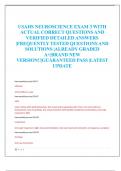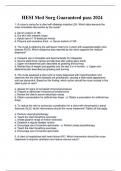USAHS NEUROSCIENCE EXAM 3 WITH
ACTUAL CORRECT QUESTIONS AND
VERIFIED DETAILED ANSWERS
|FREQUENTLY TESTED QUESTIONS AND
SOLUTIONS |ALREADY GRADED
A+|BRAND NEW
VERSION!!|GUARANTEED PASS |LATEST
UPDATE
how would you test CN I?
olfaction
smell coffee or soap
how would you test CN II?
optic
exam retinas with ophthalmoscope, test visual acutiy separately with chart, test vison with red
desaturation, test visual fields, test visual extinction with double simultaneous stimulation, test pupil
response to light
how would you test CN III?
oculomotor
test pupil response to light, test accommodation, test eye movements (smooth, convergence, saccades)
how would you test CN IV?
trochlear
test eye movements
1|Page
,how would you test CN V?
trigeminal
test face sensation and muscles of mastication (corneal reflex, tactile extinction, jaw jerk reflex), test
muscles of articulation
how would you test CN VI?
abducens
test eye movements
how would you test CN VII?
facial
test face muscles (corneal reflex), test muscles of facial expression and taste, test muscles of articulation
how would you test CN VIII?
vestibulocochlear
test hearing and vestibular sense (vestibular gag reflex using oculocephalic maneuver or caloric testing)
how would you test CN IX?
glossopharyngeal
test palate elevation and gag reflex, test muscles of articulation
how would you test CN X?
vagus
test palate elevation and gag reflex, test muscles of articulation
how would you test CN XI?
accessory
test sternocleidomastoid and trapezius muscle
how would you test CN XII?
hypoglossal
test muscles or articulation, test tongue muscles
what are different ways to conduct a motor exam?
2|Page
,1. observation
2. inspection
3. palpation
4. muscle tone testing
5. functional testing
6. strength testing
observation
observe for twitches, tremors, or other involuntary movements, or paucity (basal ganglia or cerebellum
or peripheral nerve lesions)
inspection
inspect muscles for wasting, hypertrophy, or fasciculations (intrinsic hand muscles, shoulder girdle, and
thigh)
palpation
palpate in case of myositis for tenderness
muscle tone testing
test muscle tone by having pt relax then passively move each limb to get a sense of resistance or rigidity
functional testing
test for drift and fine movements
strength testing
test MMT of muscles
0/5- no contraction
1/5- muscle flicker, no movement
2/5- movement possible but not against gravity
3/5- movement possible against gravity but not against resistance
4/5- movement possible against some resistance
5/5- max strength
What is the clonus reflex?
involuntary rhythmic, repetitive contractions of foot seen with UMN lesion
What is Hoffman's sign?
tested by holding the patient's middle finger and flicking it downward causing the finger to extend
slightly. If the thumb flexes or adducts in response, this sign is positive -- heightened finger flexors
what are the reflex grades?
3|Page
, 0 - absent
1+ - trace
2+ - normal
3+ - brisk
4+ - non sustained clonus
5+ - sustained clonus
What is the Babinski reflex?
the big toe is extended and the other toes fan in response to the brushing of the sole of the foot--
positive response
when would you use the abdominal cutaneous reflex?
for coma, spinal cord injury, frontal lobe dysfunction, neurodegerative disorders
what is appendicular coordination
ataxia is abnormal movements in coordination
look for overshoot with finger to nose test or heel-shin test
What is the Romberg test?
Tests the client's coordination, client stands with feet together and arms at sides eyes open and then
closed. Client should be able to maintain the position for 20 secs with minimal or no swaying
tests 3 sensory systems --> vision, vestibular, proprioception
what is gait?
observe walking toward and away
note stance, posture, stability, how high feet raise off the floor, trajectory of leg swing and if there is
circumduction, leg stiffness, degree of knee bending, arm swing, tendency to fall or sway, rate and
speed, difficulty initiating or stopping gait, and involuntary movements
test tandem gait, test forced gait
how can you conduct a sensory exam?
1. primary sensation, asymmetry, and sensory level
2. cortical sensation, including extinction
primary sensation, asymmetry, sensory level
test light touch, pain sensation, temperature, vibration, joint position sense, and two-point
discrimination
cortical sensation, including extinction
4|Page





